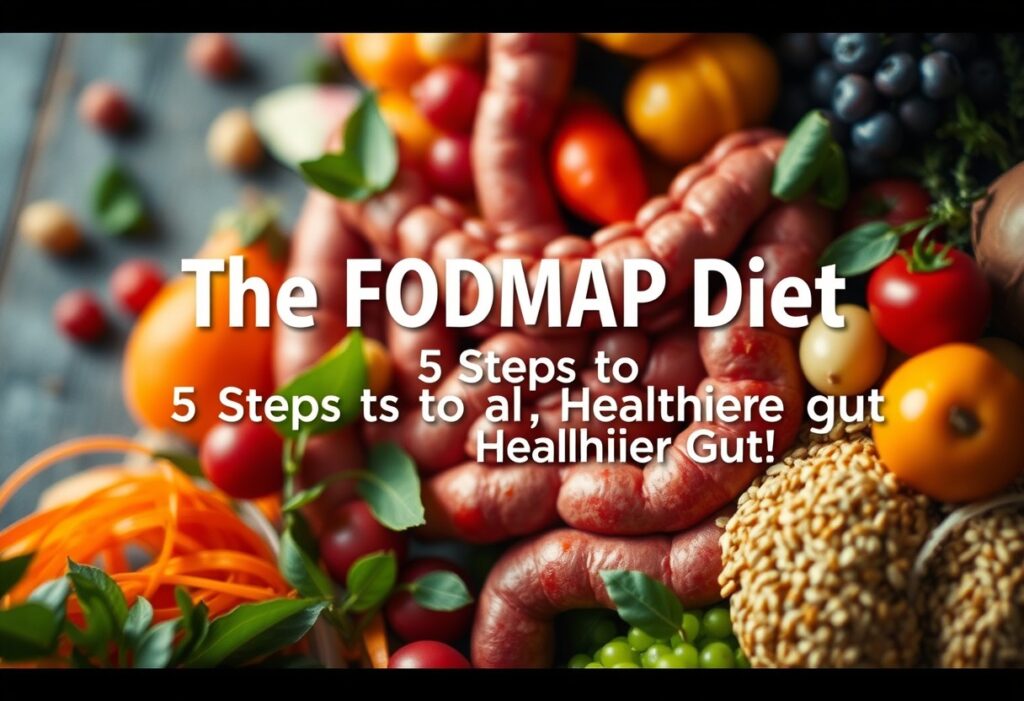Healthier Gut With The FODMAP Diet
There’s a growing wave of awareness about gut health, and the FODMAP diet is gaining popularity as a powerful tool for managing digestive issues. If you often experience bloating, gas, or discomfort after meals, this diet may offer you relief. By understanding the types of carbohydrates that can trigger these symptoms, you can tailor your eating habits to promote a happier, healthier gut. In this post, we’ll guide you through five vital steps to effectively implement the FODMAP diet in your daily routine, helping you regain control over your digestive well-being.
Table of Contents

Key Takeaways:
- FODMAPs Defined: FODMAPs are short-chain carbohydrates that can be poorly absorbed in the gut, leading to digestive issues.
- Elimination Phase: The first step of the diet involves eliminating high-FODMAP foods for 4-6 weeks to assess symptom improvement.
- Reintroduction Phase: Gradually reintroducing foods helps identify which FODMAPs are problematic for your gut health.
- Personalization: The diet is not one-size-fits-all; it is crucial to tailor the reintroduction process based on individual tolerance.
- Long-term Management: A balanced approach is necessary for long-term gut health, focusing on variety and nutrient-dense foods.

Understanding the FODMAP Diet
The FODMAP diet is a scientifically-backed approach aimed at alleviating digestive discomfort associated with certain carbohydrates. FODMAP stands for Fermentable Oligosaccharides, Disaccharides, Monosaccharides, and Polyols. These carbohydrate types are commonly found in various foods and can be poorly absorbed in your small intestine, leading to bloating, gas, and abdominal pain. The FODMAP diet is designed to help you identify and reduce the intake of these troublesome carbs, ultimately allowing you to enjoy a more comfortable digestive experience.
What Are FODMAPs?
Understanding FODMAPs is crucial for anyone looking to optimize their gut health. These short-chain carbohydrates, which include foods such as garlic, onions, certain fruits, and dairy products, are often fermented by gut bacteria, resulting in gas transit and digestive issues. People who experience conditions like irritable bowel syndrome (IBS) may find that eliminating high-FODMAP foods from their diet can lead to relief from uncomfortable symptoms.
Benefits of a Low-FODMAP Diet
FODMAP elimination can provide numerous benefits, particularly for those suffering from digestive problems. By reducing intake of high-FODMAP foods, many individuals find that their gastrointestinal symptoms, such as bloating and abdominal pain, significantly decrease, leading to enhanced overall well-being. Furthermore, this diet encourages you to be more mindful about your eating habits, promoting a greater understanding of how certain foods affect your body.
This focus on gut health is not just about relief from symptoms—it can also enhance your overall quality of life. You may experience improved energy levels and mental clarity, as well as a better emotional relationship with food. By taking control of your dietary choices through the low-FODMAP diet, you are empowering yourself to nurture your gut and enrich your well-being. This process can foster a deeper connection with what you eat and how it influences your health, ultimately leading to lasting positive changes.

Step 1: Elimination Phase
It is vital to start your journey on the FODMAP diet with the elimination phase, as this is where you begin to identify which foods are causing issues in your digestive system. By eliminating high-FODMAP foods, you allow your gut to heal and gain clarity on what adversely affects your health. This phase typically lasts for about 4-6 weeks, during which time you will meticulously track your food intake alongside your symptoms. This will help you distinguish which specific FODMAPs are too problematic for your digestive comfort.
Identifying High-FODMAP Foods
Step one is identifying high-FODMAP foods that should be eliminated from your diet. FODMAPs are categorized into several groups, including fructose, lactose, fructans, galacto-oligosaccharides (GOS), and polyols. Common high-FODMAP foods include garlic, onion, wheat products, beans, certain fruits like apples and pears, and dairy. Understanding how to navigate food labels and knowing which foods belong to these categories is crucial for your success in this elimination phase.
Tips for Successful Elimination
For an effective elimination phase, it is vital to adhere strictly to the diet and avoid any high-FODMAP foods, even in small amounts. To help you stay on track, consider the following tips:
- Plan your meals ahead of time to avoid unintentional consumption of high-FODMAP foods.
- Read food labels carefully to identify hidden FODMAPs.
- Focus on whole, unprocessed foods that are known to be low-FODMAP.
- Keep a food diary to track what you eat and how it affects your symptoms.
After you stick to this phase, you’ll be better equipped to identify problem foods and tailor your diet for improved digestive health.
Additionally, finding support during this elimination phase can be incredibly beneficial. Connecting with others who are undergoing a similar dietary change or seeking guidance from a registered dietitian can help you stay motivated and informed throughout the process. Here are some more tips to consider:
- Join low-FODMAP diet groups online for community support.
- Utilize smartphone apps designed to help you identify low-FODMAP foods.
- Experiment with low-FODMAP recipes to keep your meals exciting and varied.
After you implement these strategies, you will likely find it easier to stick with the elimination phase successfully.

It’s imperative to take care of your gut health, especially if you struggle with digestive issues. The FODMAP diet is a scientifically-backed approach designed to help you identify and eliminate fermentable carbohydrates that may trigger your symptoms. In this blog post, you’ll discover five straightforward steps to implement the FODMAP diet into your lifestyle, paving the way for a happier, healthier gut. Whether you’re experiencing bloating, gas, or other digestive discomforts, these practical tips will empower you to regain control of your well-being.
Step 3: Personalization of Your Diet
Once again, it is necessary to recognize that the FODMAP diet is not a one-size-fits-all solution. Personalizing your diet plays a crucial role in finding the right balance of foods that support your digestive health while avoiding those that trigger your symptoms. This process involves understanding your body’s unique responses to different FODMAPs and tailoring your food choices accordingly. You should keep a detailed food diary to track what you eat, how you feel, and any symptoms that arise, which will help guide your dietary adjustments moving forward.
Creating Your Own Low-FODMAP Plan
Your journey in crafting a personalized low-FODMAP plan should begin with eliminating all high-FODMAP foods for a designated period, typically 4-6 weeks. Following this initial phase, you will gradually reintroduce specific FODMAPs one at a time. This method allows you to identify which types may be problematic for you personally. As you explore various low-FODMAP foods, focus on incorporating whole, nutrient-dense options that fulfill your dietary preferences while promoting gut health.
Incorporating Variety
On your path to a happier, healthier gut, it’s vital to incorporate a diverse array of foods into your low-FODMAP plan. This not only keeps your meals exciting and enjoyable but also provides necessary nutrients that support overall well-being. A varied diet helps maintain a healthy gut microbiome, which is crucial for optimal digestion and immune function. Experiment with different cooking methods, flavor profiles, and cuisines to ensure your meals remain satisfying and rich in nutrients.
With careful planning and a commitment to diversity, you can explore the vast world of low-FODMAP foods without feeling limited or deprived. Incorporating seasonal fruits and vegetables, whole grains, and lean proteins can help you create an enticing meal plan that meets your nutritional needs while promoting gut health. Note, the goal is to make the low-FODMAP approach work for you, so enjoy the process of discovering new flavors and combinations that support your unique digestive system.

Summing up
Presently, begining on the FODMAP diet can significantly transform your digestive health and overall well-being. By following these five steps, you can identify and mitigate the triggers that lead to uncomfortable gastrointestinal symptoms. This diet is not just a temporary fix, but rather a comprehensive approach that empowers you to gain a deeper understanding of your body’s unique reactions to various foods. You will have the tools necessary to make informed choices that suit your dietary needs, leading to greater comfort and happiness in your daily life.
By committing to this process, you are taking proactive steps toward achieving a healthier gut. Be mindful of, it is crucial to approach the FODMAP diet with patience and flexibility, as it may take time to find the right balance for your individual needs. As you navigate through the phases of elimination and reintroduction, you will refine your understanding of what works best for you. Ultimately, the journey you undertake now can pave the way for a more vibrant, fulfilling lifestyle characterized by improved gut health and reduced discomfort.
FAQ
Understanding the FODMAP Diet
What is the FODMAP Diet?
The FODMAP diet is a specialized nutritional approach tailored for individuals suffering from irritable bowel syndrome (IBS) and various other gastrointestinal disorders. The acronym FODMAP stands for Fermentable Oligosaccharides, Disaccharides, Monosaccharides, and Polyols. These are types of short-chain carbohydrates that can be poorly absorbed in the intestine, often provoking symptoms such as bloating, gas, abdominal pain, diarrhea, and constipation. The FODMAP diet seeks to alleviate these symptoms by implementing a structured dietary strategy.
The primary premise behind the diet is that by lowering the intake of high-FODMAP foods, individuals can potentially ease digestive distress. Over the past decade, numerous studies have suggested a beneficial role of low-FODMAP diets in managing not just IBS, but other gastrointestinal disturbances as well. This dietary plan encompasses a temporary elimination phase to help identify specific food intolerances and is followed by systematic reintroduction of high-FODMAP foods to determine personal triggers.
The Five Steps to Following the FODMAP Diet
Implementing the FODMAP diet can seem daunting, but it can be simplified into five clear steps:
- Elimination Phase: In the first step, individuals are advised to remove all high-FODMAP foods from their diet for a duration of 4-6 weeks. This period serves as a reset to minimize gastrointestinal symptoms. It is important at this stage to remain committed and to read labels carefully, as many processed foods may contain hidden FODMAPs.
- Symptom Monitoring: Keeping a detailed food diary is crucial during this phase. By tracking daily food intake alongside any symptoms experienced, individuals can better pinpoint potential food intolerances. Ask yourself how you feel after meals and maintain comprehensive records to discern patterns, helping you identify which foods may provoke discomfort.
- Reintroduction Phase: After completing the elimination phase, the next step involves gradually reintroducing high-FODMAP foods back into the diet, one at a time. This should be done over a period of several days for each food item, allowing your body to respond and noting any changes in symptoms. The aim here is to assess tolerance levels and identify specific foods that may be problematic.
- Personalization: Based on the experiences during the reintroduction phase, it’s essential to develop a personalized diet plan. This stage allows for a more flexible approach to eating, incorporating low-FODMAP foods while identifying acceptable quantities of previously eliminated high-FODMAP foods that don’t trigger symptoms. This personalization enhances the eating experience without compromising digestive health.
- Long-term Maintenance: The final step focuses on creating a sustainable eating plan that integrates low-FODMAP foods into your daily routine. This strategy should ideally aim to minimize troubling foods, but also to ensure a diverse and enjoyable diet. This long-term approach is about finding balance—intake of low-FODMAP foods while maintaining a sufficient variety to meet nutritional needs.
Types of Foods to Avoid on the FODMAP Diet
A key aspect of the FODMAP diet is identifying and avoiding high-FODMAP foods during the elimination phase. Some categories of food to be cautious of include:
- Certain Fruits: Many fruits are high in FODMAPs, including apples, pears, cherries, and watermelon. Instead, consider low-FODMAP options like bananas, oranges, raspberries, and strawberries.
- Certain Vegetables: Vegetables known for their high FODMAP content include garlic, onions, cauliflower, and mushrooms. Low-FODMAP alternatives are carrots, spinach, zucchini, and bell peppers.
- Legumes and Pulses: While legumes like lentils and chickpeas are popular plant-based protein sources, they can be high in FODMAPs and should be restricted or consumed in small amounts.
- Dairy Products: Many dairy products contain lactose, a type of FODMAP. High-lactose dairy, such as regular milk and soft cheeses, should be limited. However, lactose-free alternatives and hard cheeses may be easier to digest.
- Sweeteners: Certain sweeteners can be problematic, particularly polyols like sorbitol and mannitol, found in some sugar-free products and high-fructose corn syrup. Options like maple syrup and sugar (in moderation) tend to be better tolerated.
By being vigilant and reading food labels, individuals can better navigate their food choices to avoid hidden FODMAPs.
Broader Health Implications of the FODMAP Diet
Emerging research indicates that the FODMAP diet may not only benefit those with IBS but may also provide relief for individuals dealing with various gastrointestinal issues, including:
- Functional Gastrointestinal Disorders (FGIDs): These disorders, encompassing a range of symptoms without an identifiable organic cause, can often be managed through the FODMAP diet.
- Inflammatory Bowel Disease (IBD): Some individuals with conditions such as Crohn’s disease and ulcerative colitis have reported symptom improvement when following low-FODMAP guidelines.
- Gastrointestinal Symptoms Related to Eating Disorders: For some individuals struggling with eating disorders, the FODMAP diet may help in addressing various gastrointestinal complaints that can arise from their eating patterns.
Despite the potential benefits, it is vital to approach the FODMAP diet with caution and to consult with a healthcare professional or registered dietitian before starting, particularly for those with existing health conditions. A personalized approach to dietary changes can ensure that nutrition is not compromised while managing symptoms effectively.
Ensuring Nutritional Adequacy on the FODMAP Diet
One of the primary concerns for individuals adopting the FODMAP diet is maintaining adequate nutrition while adhering to dietary restrictions. Here are several tips for ensuring a well-rounded intake of nutrients:
- Focus on Variety: It’s essential to consume a broad range of low-FODMAP foods to cover your nutritional bases. Lean proteins (like chicken, fish, and tofu), gluten-free grains (such as rice and quinoa), and quintessential low-FODMAP vegetables (like carrots, spinach, and zucchini) can contribute significantly to a balanced diet.
- Include Safe Dairy Alternatives: For those reducing their intake of lactose, choosing lactose-free dairy options or plant-based alternatives like almond milk, rice milk, and coconut yogurt can help ensure calcium and vitamin D needs are met.
- Emphasize Low-FODMAP Fruits: Fruits such as bananas, blueberries, orange, and kiwi are low in FODMAPs and can provide necessary vitamins and fiber. Experimenting with different combinations can keep meals exciting and nutritionally rich.
- Consult a Registered Dietitian: Working with a professional who specializes in the FODMAP diet is invaluable. A registered dietitian can help tailor individual meal plans, troubleshoot specific dietary issues, and provide education around food labels and ingredient alternatives, ensuring that both dietary restrictions and nutritional needs are met.
Additional Considerations
Implementing a FODMAP diet is not merely about removing foods; it should also be viewed as a journey of understanding your body. Patience is crucial since dietary adjustments take time to yield results. Furthermore, having a strong support system—friends, family, or online communities—can offer encouragement and shared experiences that can make the process more manageable.
Final Thoughts
The FODMAP diet offers valuable insights for those looking to take control of their gastrointestinal health. As each person’s triggers differ, the path to discovering what works best for you through this structured approach can ultimately enhance your quality of life. Keep in mind that it’s a journey, not a race, and with each step, you’re contributing to a deeper understanding of your body and how your dietary choices impact your health. Whether managing symptoms of IBS or other gastrointestinal conditions, the FODMAP diet can be an effective tool in cultivating a healthier relationship with food.



